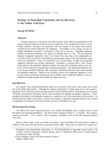Ecology of Degraded Vegetation and Its Recovery in the Indian Arid Zone
JIRCAS international symposium series
| ISSN | 13406108 |
|---|---|
| NII recode ID (NCID) | AA1100908X |

Full text
intlsymp-1_27-37.pdf363.04 KB
Natural vegetation in the Indian arid zone is sparse, spiny, bushy and stunted due to the adverse climate conditions and the presence of soils with a low nutrient level and low water-holding capacity. Excessive use associated with the increase of the human and livestock populations has further degraded this vegetation. Knowledge on the ecology of such degraded vegetation is essential to formulate to plans for its recovery. Degraded vegetation exhibits an altered composition, low vigour, low density and low cover. The above-ground biomass of degraded vegetation is four to six times lower than that of the undegraded one. The bulk of this low yield is contributed by annual grasses, annual forbs and perennial weeds which are unpalatable. Thus, the palatability and nutrient status of feeds from degraded vegetation decrease and become unbalanced. Dominance of species with a lower successional status in the degraded vegetation further decreases their ecological status as the majority of these species are therophytes and hemicryptophytes. The dominance-diversity relations become markedly different, with a geometric dominance-diversity curve characterizing the degraded vegetation. Based on the ecological status of the degraded vegetation, its recovery requires protection varying from six to fifteen years in different habitats in the low, moderate and high rainfall zones within the Indian arid zone.
| Creator | Suresh KUMAR |
|---|---|
| Publisher | Japan International Research Center for Agricultural Sciences |
| Available Online | |
| Issue | 1 |
| spage | 27 |
| epage | 37 |
| Language | eng |
